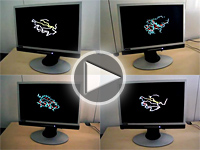completed
Elite-program for postdoctoral researchers of the "Landesstiftung Baden-Wuerttemberg"
 In learning tasks, visual attention is often considered as important mediator
for processes of knowledge acquisition. For example, the spatial separation
of semantically related information may impede attention, which in turn may
affect learning. In this project we address this important issue by manipulating
the attentional demands of various learning conditions. One way of doing so
is to attract attention of learners to different parts of complex mechanical
devices by manipulating the presentation speed of the animation. Another way
to foster attentional processes is to make use of a so-called autostereoscopic
display technology, which enables the simultaneous presentation of two related
visualizations in an integrated way. Here the learner does not have to split
the attention between two separate displays but instead just has to slightly
move his head when he wants to switch between the two presentations.
In learning tasks, visual attention is often considered as important mediator
for processes of knowledge acquisition. For example, the spatial separation
of semantically related information may impede attention, which in turn may
affect learning. In this project we address this important issue by manipulating
the attentional demands of various learning conditions. One way of doing so
is to attract attention of learners to different parts of complex mechanical
devices by manipulating the presentation speed of the animation. Another way
to foster attentional processes is to make use of a so-called autostereoscopic
display technology, which enables the simultaneous presentation of two related
visualizations in an integrated way. Here the learner does not have to split
the attention between two separate displays but instead just has to slightly
move his head when he wants to switch between the two presentations.